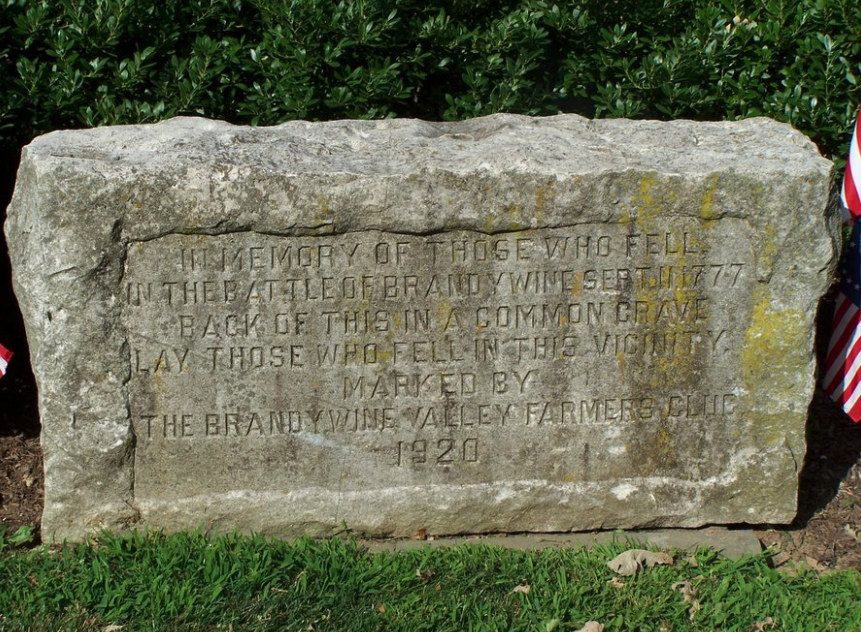John CHILTON
SAR Patriot #:
P-132544
The following information was assembled from numerous sources and cannot be used directly as proof of Qualifying Service or Lineage.
It is considered a research aid and is intended to assist in locating sources that can be used as proof.
State of Service: VA
Qualifying Service: Captain
DAR #: A021605
Birth: 29 Aug 1739 / Westmoreland / VA
Death: 11 Sep 1777 Brandywine / Chester / PA
Qualifying Service Description:
- Colonel Thomas Marshall, 3rd Virginia Regiment from April 2, 1775 to Sept 11, 1777
- He was killed at Battle of Brandywine where the Third Virginia was nearly annihilated, after saving the American Army, Continental Troops
Additional References:
- NSSAR RC # 140482 Anc: Capt John Chilton, App 30 Jul 1998
- DAR Cite:
- BLWT 519-300
- SANCHEZ-SAAVEDRA, A GUIDE TO VA MIL ORGS IN THE AM REV, pg 16, 40
- HEITMAN, HIST REG OF OFFICERS OF THE CONT ARMY DURING THE WAR OF THE REV, 1775-1783, pg 154
- Historical Register of Virginians in the Revolution, by Gwathmey; copies of clippings from Palmyra Spectator, 07 Jul 1976
Spouse: Letitia Blackwell
Children: George; Joseph; James; Anna; Lucy;
Members Who Share This Ancestor
| Date Approved | Society | ACN | SAR Member Info | Lineage via Child | View Application Detail | |
|---|---|---|---|---|---|---|
| 1948-03-25 | IL | Unassigned | Leland Scott McLeod (61628) | George | ||
| 1960-02-29 | OH | Unassigned | Ernest Baker Heavilon (84872) | George | ||
| 1990-05-09 | MO | 218197 | Wilbur Ross Scott (134957) | George | ||
| 1992-07-01 | KS | 212953 | Donald Ross Scott (139114) | George | ||
| 1998-07-30 | AZ | 1534 | Louis Moreland Newton MD (140482) | George | ||
| 2001-11-05 | KY | 10981 | Roy Leon Ashcraft Jr. (156812) | George | ||
| 2002-06-03 | KY | 13365 | James Godfrey Hodge Jr. (158396) | George | ||
| 2002-11-04 | AZ | 14674 | Andrew Scott Newton (159308) | George | ||
| 2003-04-08 | KS | 15737 | Christopher Ross Scott (160062) | George | ||
| 2003-04-08 | KS | 15738 | Kenneth Ryan Scott (160061) | George | ||
| 2003-04-08 | KS | 15741 | Kenneth Ross Scott (160057) | George | ||
| 2003-04-08 | KS | 15742 | Douglas Randall Scott (160058) | George | ||
| 2003-04-08 | KS | 15743 | Jeffrey Robert Scott (160059) | George | ||
| 2003-04-08 | KS | 15744 | Donald Russell Scott (160060) | George | ||
| 2005-12-30 | KY | 24503 | Robert Allen Brent (161633) | George | ||
| 2009-11-02 | CA | 34501 | Robert Jeb Moore (175319) | George | ||
| 2012-02-03 | KY | 45973 | Bradford Allen Robison (182307) | George | ||
| 2014-11-03 | KY | 58028 | Stephen Michael Robison (192686) | George | ||
| 2015-12-04 | VA | 66703 | Harley Anton Stewart (188902) | George | ||
| 2019-01-18 | MD | 84645 | Michael Condon Ransdell (210256) | Lucy | ||
| 2019-06-14 | MD | 70052 | Charles Allen Padgett (190793) | Lucy | ||
| 2022-03-04 | TN | 100931 | Francis Scott Denney (221909) | George | ||
| 2025-01-31 | WV | 114990 | Sutton Timothy Ulman (232532) | Nancy |
Location:
West Chester / Chester / PA / USA
Find A Grave Cemetery #:
Marker Type:
Group marker
SAR Grave Dedication Date:
Comments:
- Grooup marker, patriot contemporary, legible, horizontal stone
- Find-A-Grave Memorial ID#62866486 photo, provided courtesy and with permission from Robin Simmons
Directions to Cemetery / Gravesite:
- From Philadelphia International Airport: Exit the airport, enter I95 South. Exit I95 at US 322
- Travel west on US 322 to Oakland Road, at Concordville. Drive to Birmingham Road, turn left
